Illinois is known for its diverse range of flora and fauna that make it a haven for nature enthusiasts. However, not many know about the fascinating world of mushrooms that thrive in this state. With over 1000 species of fungi, mushroom hunting and photography has become a popular activity in recent years.
What are the common mushrooms of Illinois? In this Midwest state you can find hen of the woods, morels, fly agarics, honey mushrooms, chanterelles and puffballs.
This article aims to provide an overview of these common fungi and others that favor the terrain and weather in the Prairie State.
List of Mushrooms in Illinois
1. Morels
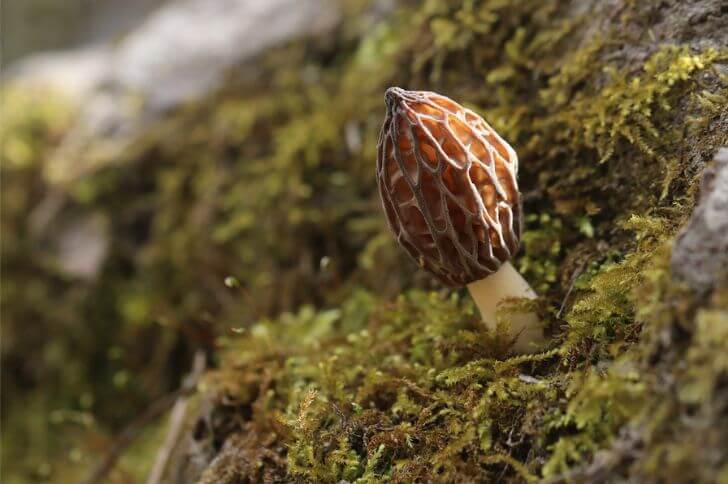
Morels are one of the most sought-after mushrooms in Illinois. They have a unique appearance with their honeycomb-like cap and hollow stem.
Morels thrive in moist soil, particularly near oak trees or old orchards. They are found during springtime when temperatures rise above 50°F for several days.
Morels have a distinct flavor profile that is earthy, nutty, and meaty. They can be eaten raw or cooked in various ways such as sautéed with butter, added to soups and stews, or even used as a pizza topping.
Where do you find morels in Illinois? Morels are found throughout the state. Note, they start popping out in the southern part of the state during the last week of March.
First counties to morels include Alexander, Williamson and White. By early May, these mushrooms will have spread throughout the state and can be found in Central and Northern Illinois.
2. Hen of the woods
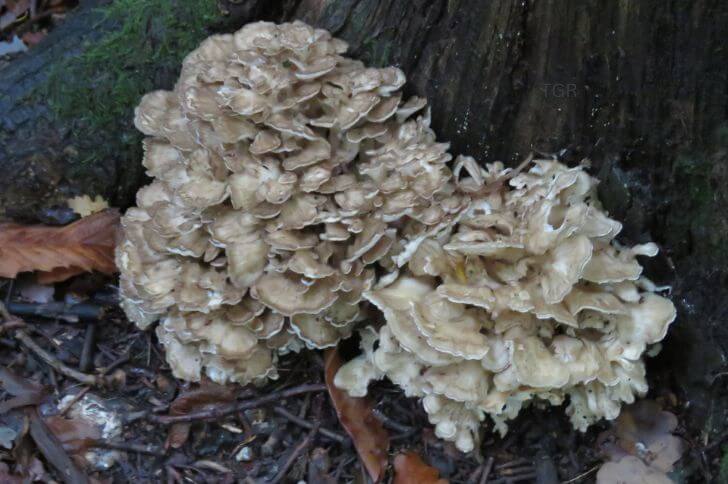
Are there hen of the woods in Illinois? Yes. hen of the woods, also called grifola frondosa or maitake, is a delicious mushroom that can be found in Illinois. It grows on the base of oak trees and can weigh up to 50 pounds. The mushroom’s name comes from its appearance, which resembles the ruffled feathers of a hen.
The flavor profile of this large mushroom is mealy and mushroomy, making it a popular ingredient in many dishes. It pairs well with pasta, chicken, and potatoes. Additionally, it contains numerous health benefits.
While harvesting this wild mushroom, ensure to pick younger maitakes. They are delicious.
3. Ringless Honey Mushrooms
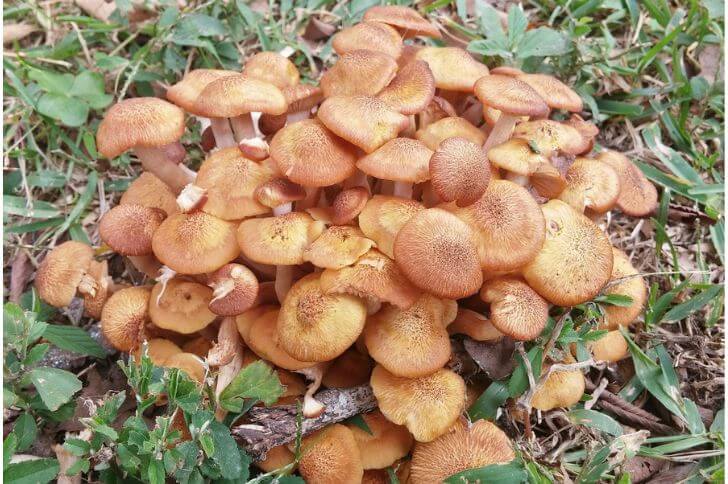
Formerly called armillaria tabescens, the desarmillaria caespitosa is a brown fungus that grows in clusters in yards and parks. Its common name is ringless honey mushroom because it lacks the characteristic ring on its stem that other honey mushrooms have.
Another way to identify this brown mushroom is to look at its cap. The cap is typically light brown or tan. Another important characteristic of this mushroom is its gills which are whitish. Their brownish stalks are long and fused at the base.
How can you cook honey mushrooms? These Illinois mushrooms taste best when stewed, roasted or braised. Ensure to thoroughly cook for 30 minutes to 1 hour.
Related: Check Minnesota fungi
4. Northern Tooth Fungus (Climacodon septentrionalis)
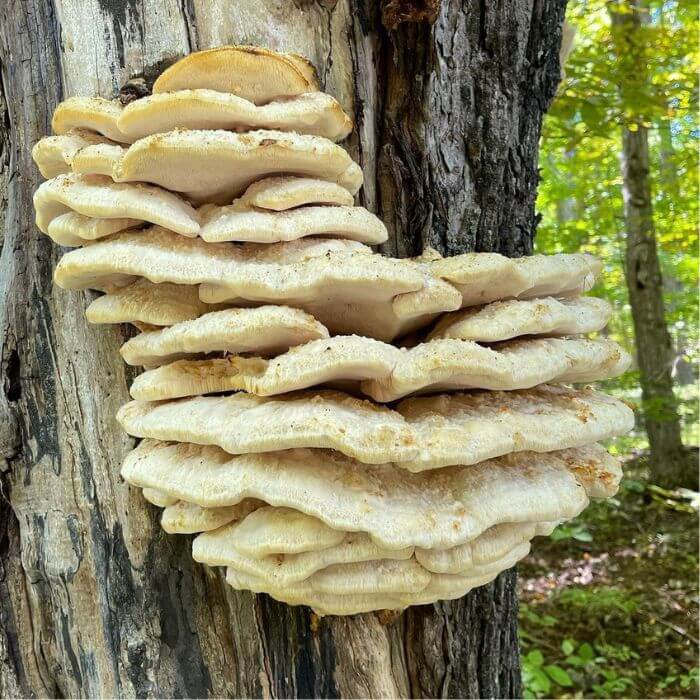
source: ordovician_silurian
Northern tooth fungus is a common summer mushroom in Illinois that belongs to the family Meruliaceae. It typically grows on sugar maple, green ash and beech. The fungus has a unique morphology that can be used to identify it from other similar species.
The fruiting bodies of these white mushrooms are characterized by their fan-like shape, similar to chicken of the woods.
The top side of the cap can be hairy or rough while the underside has short white spines. Though this white Illinois mushroom is listed as edible, many mushrooms have found it unpalatable.
Its large body can be tough and bitter. Also, as it ages this tooth fungus produces a foul smell.
5. Giant Puffball (Calvatia gigantea)
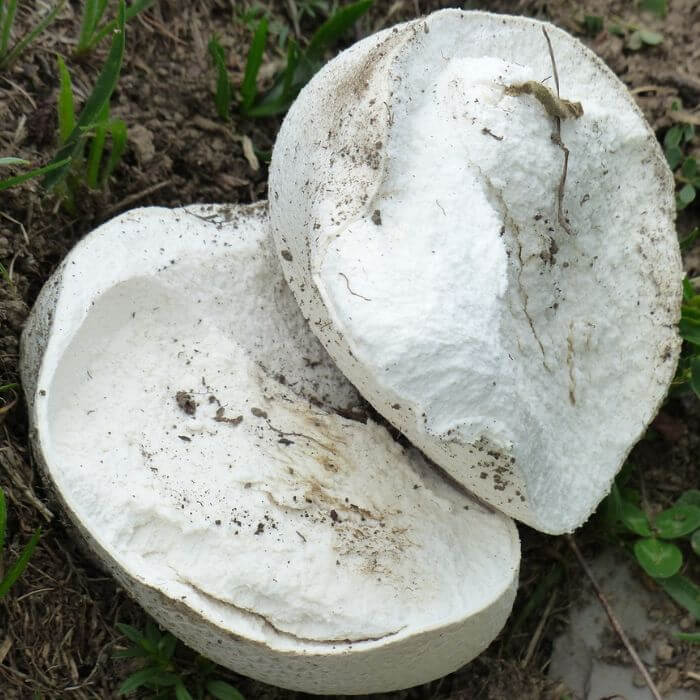
Calvatia gigantea, locally called giant puffball mushroom, is a large edible white fungus found in meadows and pastures throughout Illinois. It is one of the largest mushrooms in the state and can grow up to 3 feet in diameter.
Its fruiting body is spherical, like a ball, with a firm white flesh when young that later turns into a powdery mass.
These white mushrooms in Illinois are often eaten sautéed, grilled or fried with eggs or other dishes due to their meaty texture. When harvesting this mushroom, I often go for younger puffballs because they have firmer meat and taste better.
6. Berkeley’s Polypore (Bondarzewia Berkeleyi)
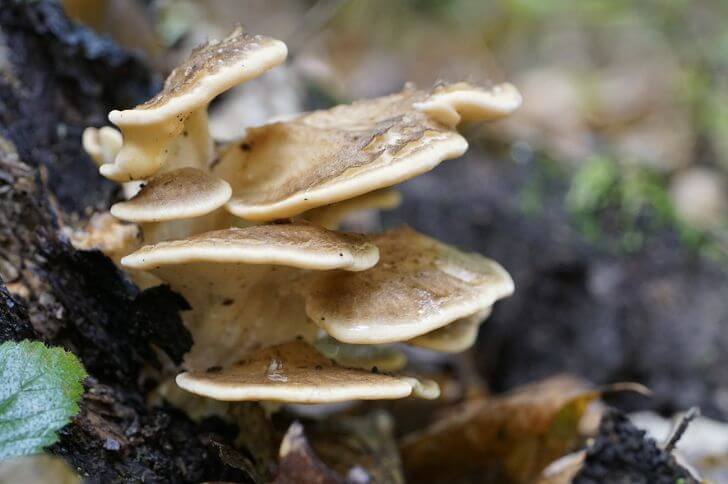
Most polypores are inedible. However, the berkeley’s polypore is one of the edible options in the wild. Commonly consumed in Asia, this large fungus can also be found in Illinois.
A member of the family bondarzewiaceae, this mushroom has a unique appearance with a thick, fleshy fan-shaped cap that can reach up to 10 inches in diameter. Like the hen of the woods above, its fruiting body is characterized with several caps joined to one, short stem-like structure.
The surface of the berkeley’s polypore is velvety and white in immature specimens changing to creamy in maturity. In Illinois, you can find this polypore from June to October.
7. Shaggy Ink Cap
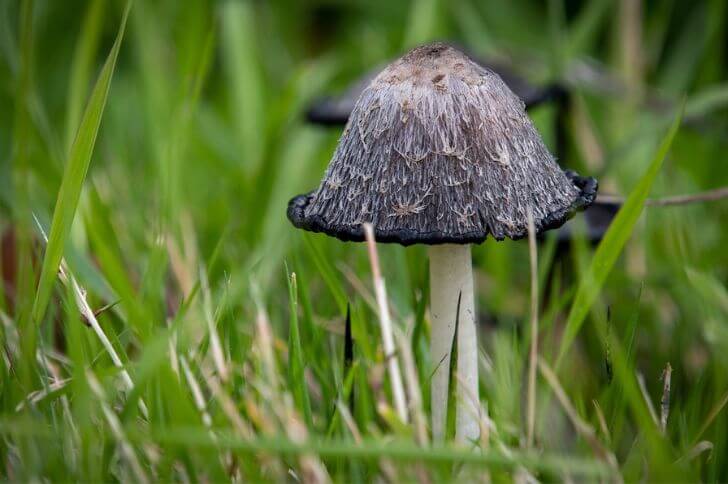
Also called the lawyer’s wig, shaggy ink caps are one of the most common white mushrooms in Illinois. This edible mushroom has a unique appearance that makes it easy to identify.
It can grow up to 7.5 inches tall with a bell-shaped cap that is covered in shaggy white scales or tufts. The cap initially appears rounded but eventually flattens out, revealing the gills beneath.
The gills are initially white, but as the mushroom matures, they turn pink and eventually black. As the name suggests, this mushroom releases black ink when its cap begins to decompose. The stem is long and slender and may have a loose ring.
Its flesh is thin and white with no distinct smell or taste.
8. Chanterelles
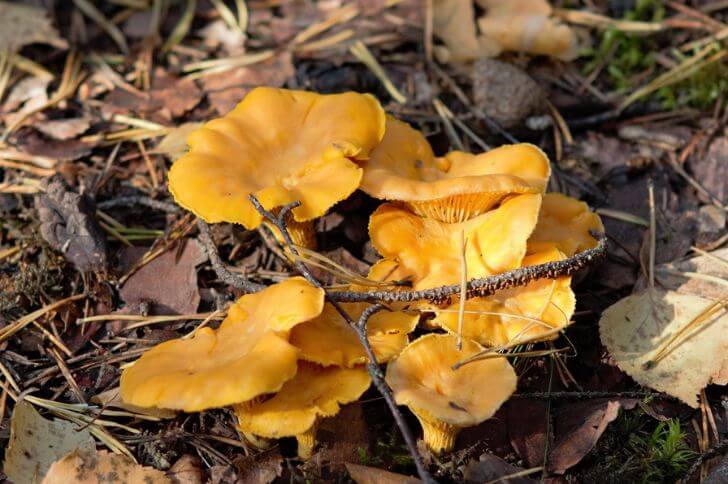
What are the chanterelle varieties in Illinois?
Cantharellus chicagoensis: The Chicago chanterelle is a rare species of mushroom primarily found in the Midwestern United States.
The most notable feature is its bright yellow coloration. It also has a vase-shaped cap with false gills that curve downwards. The stem itself is typically hollow, and grows to about 3.9 inches in height.
Cantharellus appalachiensis: Another common chanterelle in the eastern part of the country is this small mushroom. Also called the Appalachian chanterelle, it has a distinct trumpet-shaped cap that ranges from yellow to orange coloration.
The cap’s underside also features ridges rather than gills or pores. Additionally, it has a smooth stem that ranges in color from pale yellow to white.
Smooth chanterelle: You can identify it by its egg-yellow color, vase-shaped fruiting body with wavy edges on its cap. Also note its fragrant apricoty smell.
9. Crown Coral
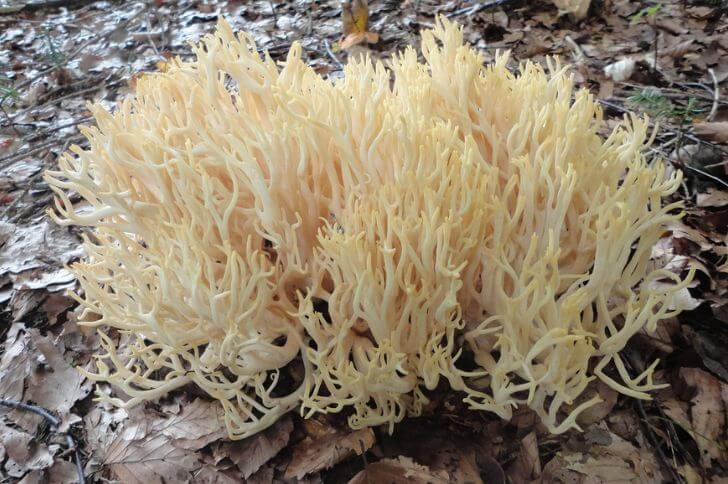
Did you know coral mushrooms are edible? Crown corals are one of the most common coral fungi in Illinois and they are edible.
Scientifically called artomyces pyxidatus or crown-tipped coral, this species belongs to the family auriscalpiaceae. It is distinguished by its unique fruiting body.
It can grow to 5.1 inches tall and 3.9 inches wide. This fungus is white to pale yellow when young, changing to pinkish as it matures. It tastes best when fried.
10. Chicken of the Woods
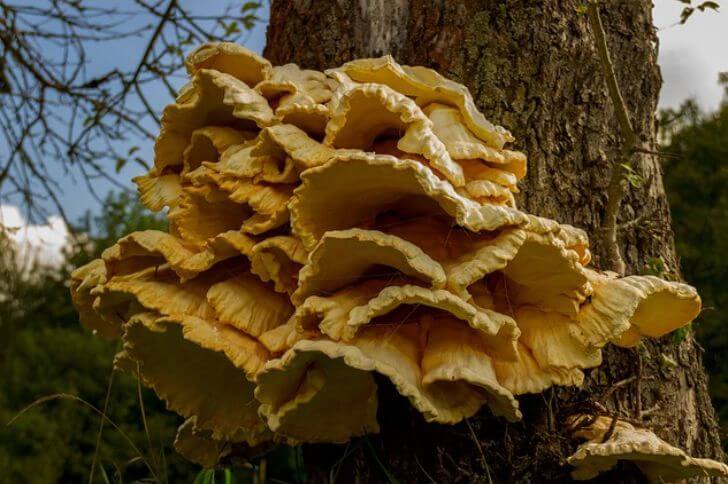
Laetiporus sulphureus, commonly sulfur shelf mushroom or chicken of the woods, is a type of bracket fungus that can be found growing on trees. It has a bright yellow to orange color and a distinct shelf-like shape. The sulfur shelf mushroom is an edible species and is often used as a meat substitute due to its meaty texture and savory flavor.
In Illinois, the chicken of the woods can be found growing on hardwood trees such as oak and cherry. It typically appears in late summer or early fall and can continue to grow for several weeks.
Also read: Check Arkansas Mushrooms
11. Amber Jelly
Though considered edible, the amber jelly is too small to collect for food. But, its common in Illinois and that’s why we’ve included it on this list.
Scientifically called exidia recisa, it is a jelly fungus species that belongs to the family auriculariaceae. It is also commonly referred to as willow brain fungus due to its unique physical characteristics.
The fungus has a rubbery and gelatinous fruiting body with lobed ears that are often found growing on dead tree branches, twigs, and logs.
The color of Exidia recisa varies depending on its stage of development but generally ranges from dark brown when immature to dull brown or black upon maturity.
Exidia recisa is edible but not widely used for culinary purposes due to its bland taste, size and texture.
12. Dryad’s Saddle
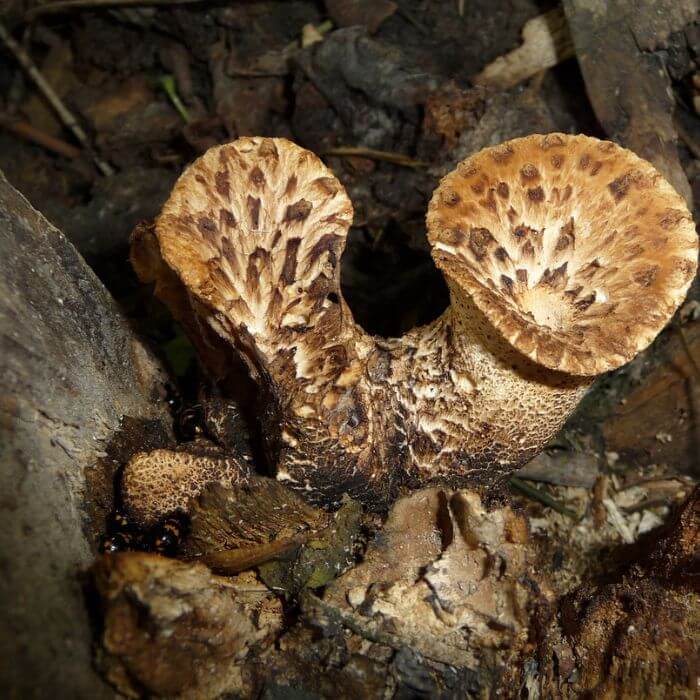
Polyporus squamosus or the dryad’s saddle is a large and edible fungus found across Illinois. It is a parasitic mushroom that grows on dead or living elms, box elders, maples, willows and poplars.
The fruiting body can grow up to 12 inches in diameter with a yellow-tan cap and creamy pores underneath.
Its white flesh is tough but edible when cooked properly, and it has a floury/watermelon odor. When can you find dryad’s saddle? Its common across the state in spring.
13. Oyster Mushrooms
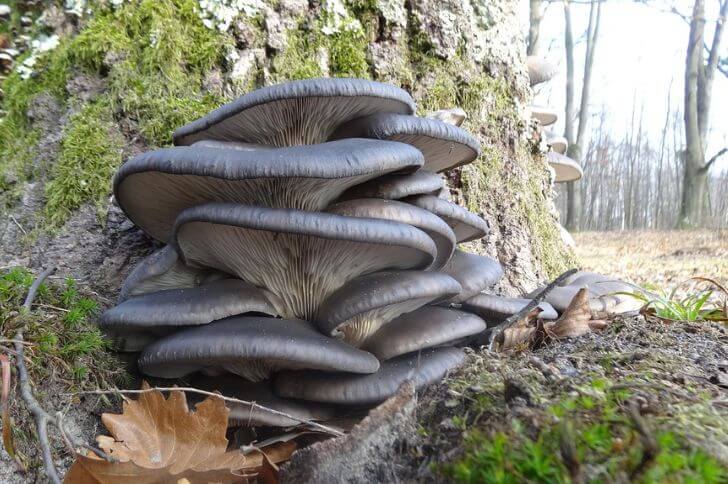
Oyster mushrooms are another type of common mushroom in Illinois. It belongs to the Pleurotaceae family.
In Illinois, oyster mushrooms are found growing wild in forests or can be cultivated through indoor farming methods.
The first step in identifying oyster mushrooms in the wild is knowing what they look like. They have a distinctive shape that resembles a fan or a shell. They grow in clusters and can range in color from pale gray- light brown. The caps are usually broad with edges that curl inwards.
14. Fairy Ring Mushroom
Marasmius oreades, commonly called the fairy ring mushroom, is a small and delicate species of mushroom that grows extensively throughout IL. It has a distinct cap that retains the umbo even in maturity.
The cap can range in color from light brown to orange-brown, and it typically measures between 0.5-2 inches in diameter. The gills underneath the cap are closely spaced and are lighter in color than the cap.
Another recognizable feature is its growth pattern. This type of mushroom grows in large circles, forming what is known as a “fairy ring.” These rings can measure several feet across. Fairy ring mushrooms are edible.
15. Lobster Mushrooms
Hypomyces lactifluorum, also known as lobster mushroom, is a unique and highly prized type of fungus. It is considered a parasite that grows on other mushrooms, particularly species in the Russula or Lactarius genus.
The result of this parasitic relationship is a bright orange-red mushroom with a distinct texture and flavor that resembles cooked lobster meat.
The easiest way to identify this IL mushroom is by its color and texture.
The fungus has an unmistakable bright orange-red hue and often appears wrinkled or lobed like the shell of a lobster. Underneath the surface, it has dense white flesh. This orange mushroom is edible.
16. Lion’s Mane
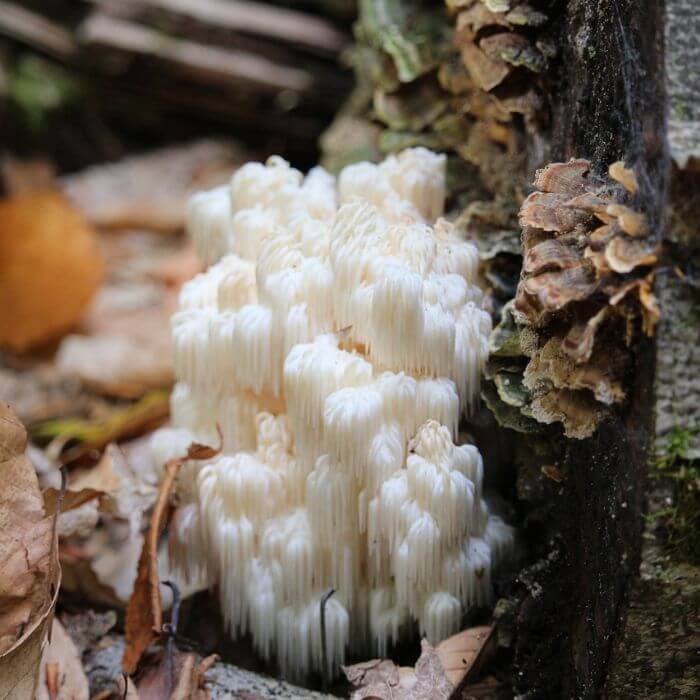
Another type of white edible mushroom you can find in the wild in IL is the lion’s mane. It belongs to the tooth mushroom family. It is widely found in North America, Europe, and Asia.
The fruiting body resembles a white globular mass with long spines hanging down from it. These spines are soft when young but become brittle as they mature.
In Illinois, lion’s mane grow on hardwood particularly as maple and beech during the fall season. It is a popular choice among mushroom enthusiasts who use it in dishes like soups or stir-fries.
And like the oysters above, lion’s mane can be cultivated.
Inedible Mushrooms of Illinois
17. Urnula Craterium
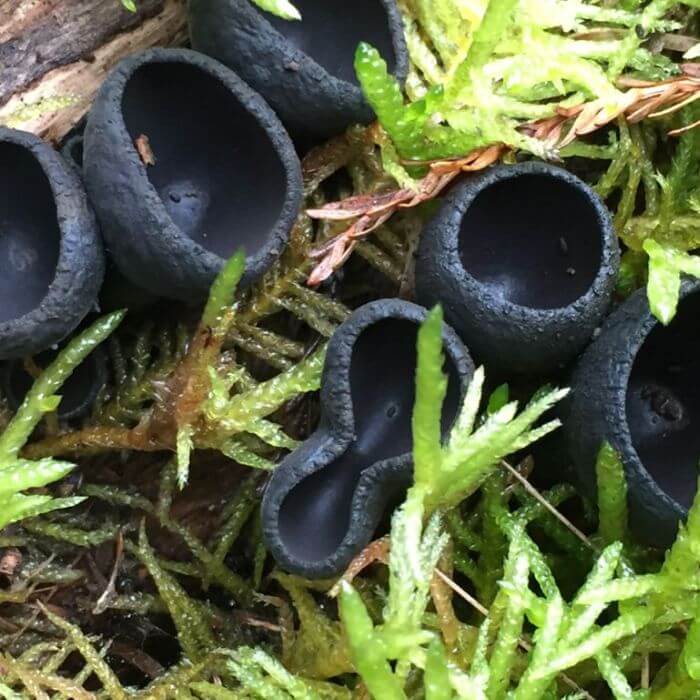
source:rachel_m_marks
Urnula craterium is a species of fungi commonly referred to as the black cup. It belongs to the family sarcoscyphaceae and is known for its distinctive shape, which resembles a shallow bowl. This fungus can be found growing on decaying wood during the spring months.
It’s about 1.2-1.6 inches in diameter. The outer surface of this fungus is typically brown-black and velvety, while the inner surface appears smooth and brownish-black. Additionally, its stalk-like structure connects directly to the center of the fruiting body.
18. Yellow Gymnopilus
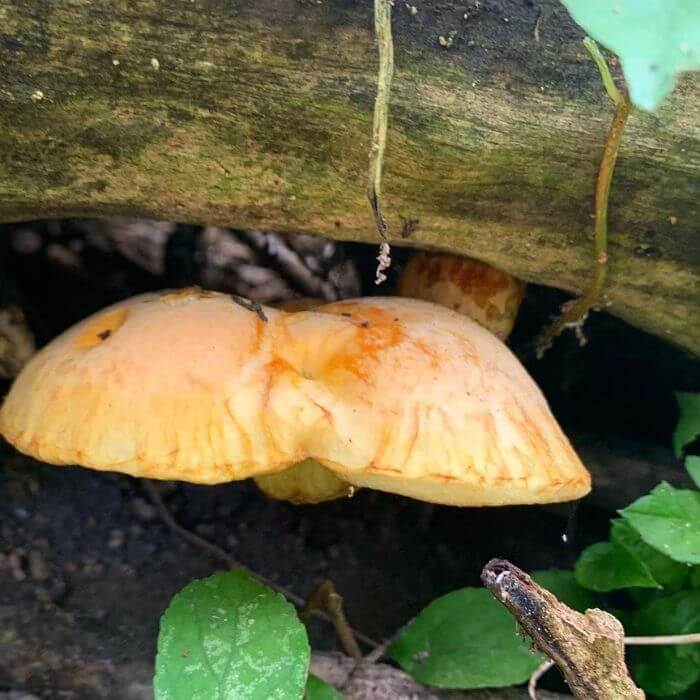
source: 219naturalist
Gymnopilus luteus, commonly called the yellow gymnopilus, is an inedible species of mushroom in Illinois that belongs to the family Hymenogastraceae. It is a saprobic fungus that grows on dead wood and woody debris in deciduous forests from June through to November.
The yellow gymnopilus is characterized by its bright orange-yellow cap with a convex to flattened shape, pale yellow gills that often turn rusty-red with age, and a stout stem that can reach up to 3.9 inches.
Notice their orange-brown spore print. These Illinois mushrooms are bitter and inedible.
19. Banded Mottlegill (Panaeolus Cinctulus)
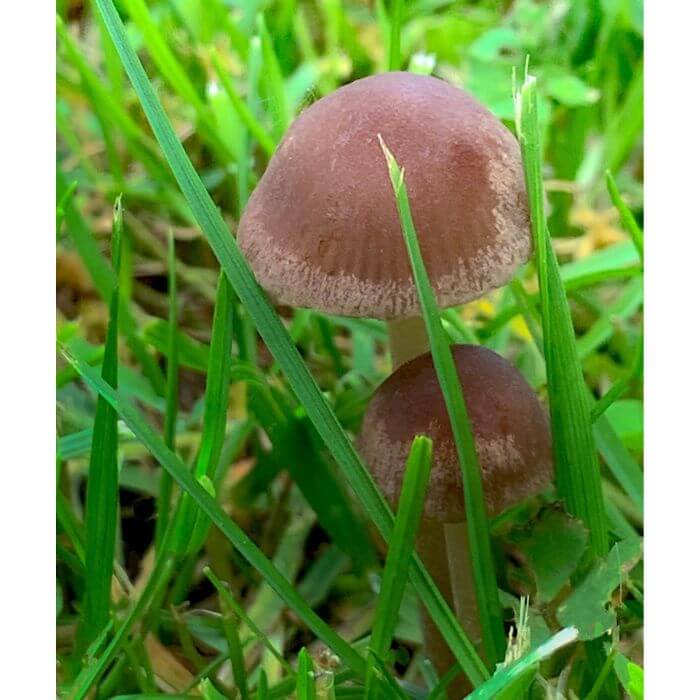
Panaeolus cinctulus is a species of mushroom that belongs to the genus Panaeolus. It is commonly known as the banded mottlegill, and it is common in many parts of the states.
This mushroom has a unique appearance with its distinctively patterned hemispherical cap when young that has blackish-brown bands. Note, the outer band is darker.
As the banded mottlegill ages, the cap becomes broader and flat. Underneath, young species have creamy gills that’ll eventually turn brown and sooty black in maturity. The banded mottlegill is inedible.
20. False Parasol
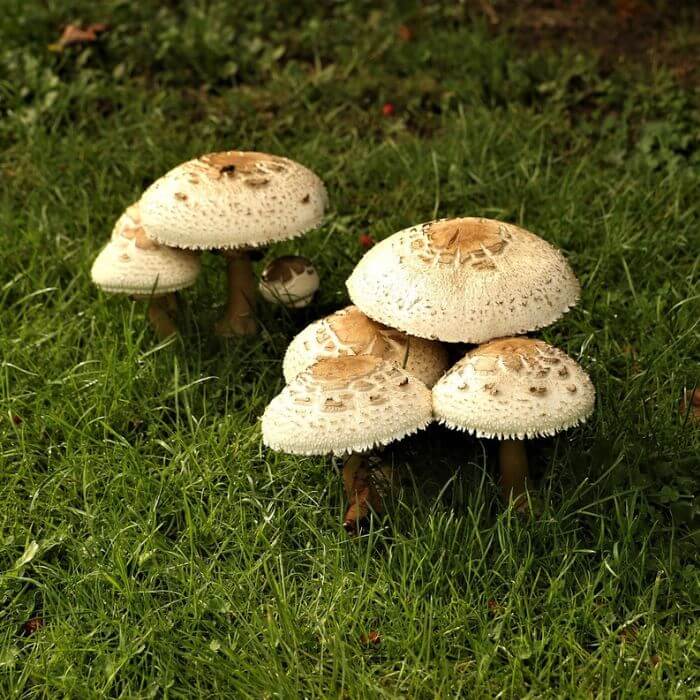
Chlorophyllum molybdites, commonly known as the “false parasol,” is an inedible Illinois mushroom that resembles the edible parasol mushroom.
The false parasol grows up to 11 inches in diameter, with a convex cap that flattens as it matures. The cap has brown scales on top with white gills underneath. Note their green spore prints which gives them their other name; green-spored lepiota.
The stem is thin and long with a notable double-edge ring. Their soft white flesh does not change when cut. If you cannot tell this white mushroom apart from the edible variety, we recommend you avoid picking this species.
FAQs
Can you mushroom hunt in state parks in Illinois?
The answer is yes and most parks allow foragers to hunt for mushrooms during the summer, spring and fall seasons when the fungi are in abundance.
What are bright orange mushrooms in Illinois?
Jack-O-Lantern mushroom. Its name comes from its bright orange color and glowing appearance, which resembles the famous Halloween decoration. Note, it is inedible.
What wild mushrooms are edible in Illinois?
Common edible wild mushrooms of Illinois include chanterelles, morels, puffballs, lobsters, honey mushrooms, lion’s mane and oysters.
Are truffles found in Illinois?
The answer is yes, but not all types of truffles can be found in Illinois. The most common type of truffle that grows in this state is the black truffle (Tuber melanosporum). Black winter truffles have been successfully cultivated in various parts of Illinois, including Champaign County and Vermilion County.
Do chanterelles grow in Illinois?
One of the most common types of chanterelles found in Illinois is the golden chanterelle. These mushrooms have a bright yellow-orange cap with an apricot-like aroma and are known for their meaty texture. Another variety, the black trumpet, has a trumpet-shaped cap which ranges from brown to black. It offers an intense flavor .
What is the red capped mushroom in IL?
Fly agaric. It sports a distinctive red cap with white spots. These fungi are inedible.
Source:
Hi There,
My name is Jenny. I’m the Chief Editor at Try Green Recipes and besides making yummy and healthy foods for my kids, grandkids, and friends. I’m new to the blogging world but I believe what I have to share is unique and will bring joy to your home. If you are adventurous and want try something tasty, let’s get started.

